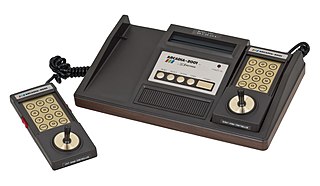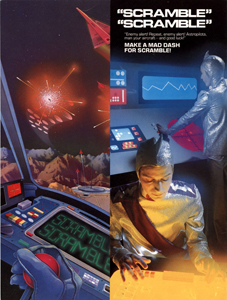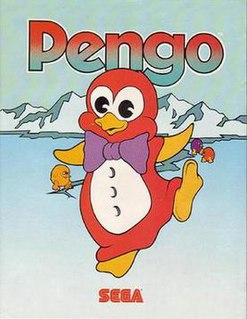
The Arcadia 2001 is a second-generation 8-bit home video game console released by Emerson Radio in May 1982 for a price of US$ 99, several months before the release of ColecoVision. It was discontinued only 18 months later, with a total of 35 games having been released. Emerson licensed the Arcadia 2001 to Bandai, which released it in Japan. Over 30 Arcadia 2001 clones exist.

Centipede is a 1981 fixed shooter arcade game developed and published by Atari, Inc. Designed by Dona Bailey and Ed Logg, it was one of the most commercially successful games from the golden age of arcade video games and one of the first with a significant female player base. The primary objective is to shoot all the segments of a centipede that winds down the playing field. An arcade sequel, Millipede, followed in 1982.

Berzerk is a multidirectional shooter maze game, released for arcades in 1980 by Stern Electronics of Chicago. Berzerk places the player in a series of top-down, maze-like rooms containing armed robots.

Scramble is a side-scrolling shooter game released for arcades in 1981. It was developed by Konami, and manufactured and distributed by Leijac in Japan and Stern in North America. It was the first side-scrolling shooter with forced scrolling and multiple distinct levels. It was a commercial success, selling 15,136 arcade cabinets in the United States within five months and becoming Stern's second best-selling game. Its sequel was the more difficult Super Cobra.

Dig Dug is a maze arcade game developed by Namco in 1981 and released in 1982, distributed in North America by Atari, Inc. Controlling the titular character, the player is tasked with defeating all of the enemies in each stage, done by either inflating them with an air pump until they pop or crushing them underneath large rocks. It runs on the Namco Galaga arcade board.

Pengo (ペンゴ) is an arcade game developed by Coreland and published by Sega in 1982. The player controls Pengo, a red penguin that resides in the Antarctic. The game takes place in an overhead maze made of ice blocks, where Pengo crushes blob-like Sno-Bees by sliding blocks into them. The objective is to survive each round by eliminating all Sno-Bees and Sno-Bee eggs, while optionally lining up the three diamond blocks for a large bonus.
1980 saw the release of a number of games with influential concepts, including Pac-Man, Battlezone, Crazy Climber, Mystery House, Missile Command, Phoenix, Rally-X, Space Panic, Stratovox, Zork, and Olympic Decathlon. The Atari VCS grew in popularity with a port of Space Invaders and support from new developer Activision.

Amidar is a video game developed by Konami and released in arcades in 1981 by Stern. The format is similar to that of Pac-Man: the player moves around a fixed rectilinear lattice, attempting to visit each location on the board while avoiding the enemies. When each spot has been visited, the player moves to the next level. The game and its name have their roots in the Japanese lot drawing game Amidakuji. The bonus level in Amidar is a nearly exact replication of an Amidakuji game and the way the enemies move conform to the Amidakuji rules; this is referred to in the attract mode as "Amidar movement."
Targ is a 1980 arcade maze shoot 'em up game developed by Exidy, depicting vehicular combat in a future world. Targ was released in North America by Exidy in June 1980, and then released in Japan by Sega in July 1980.

Apple Panic is a game for the Apple II programmed by Ben Serki and published by Broderbund Software in 1981. Apple Panic is an unauthorized version of the 1980 arcade game Space Panic, the first game with ladders and platforms. While the arcade original remained obscure, Apple Panic became a top seller for home computers. It was ported to the Atari 8-bit family, Commodore VIC-20, IBM PC, and TRS-80.

Wizard of Wor is an arcade game released in 1980 by Midway. Up to two players fight together in a series of monster-infested mazes, clearing each maze by shooting the creatures. The game was ported to the Atari 8-bit family, Commodore 64, Atari 2600, and Atari 5200 and renamed to The Incredible Wizard for the Bally Astrocade. The original cartridge came with a cash prize offer to the first person to complete the game.

Loco-Motion, known as Guttang Gottong in Japan, is an arcade puzzle game developed by Konami in 1982 and released by Sega in Japan. The North American rights were licensed to Centuri. In Loco-Motion, the player builds a path for their unstoppable locomotive by moving tracks which will allow it to pick up passengers.

The Tomy Tutor, originally sold in Japan as the Pyūta (ぴゅう太) and in the UK as the Grandstand Tutor, is a home computer produced by the Japanese toymaker Tomy. It was architecturally similar, but not identical, to the Texas Instruments TI-99/4A, and used a similar Texas Instruments 16-bit CPU. The computer was launched in Japan in 1982, and in the UK and the United States in the next year.

Serpentine is a video maze game written by David Snider for the Apple II and published by Broderbund in 1982. Serpentine's gameplay and visuals are similar to the Konami arcade game, Jungler, released the previous year. It was ported to the Commodore 64 and Atari 8-bit family, and a VIC-20 version was licensed to Creative Software.

Jump Bug is a 1981 scrolling platform-shooter game developed by Alpha Denshi under contract for Hoei Corporation. It was distributed in arcades by Sega in Japan and Europe, and by Rock-Ola in North America. It was the first platform game to include smooth horizontal and vertical scrolling. Jump Bug was ported to the Emerson Arcadia and the Leisure Vision system.

Head On is an arcade video game developed by Sega/Gremlin and released by Sega in 1979. It's the first maze game where the goal is to run over dots. Designed by Lane Hauck at Sega/Gremlin in the United States, the game was a commercial success, becoming the fourth highest-grossing arcade video game of 1979 in both Japan and the United States.

Munchman is a tabletop electronic game that was released under licence in 1981 in the UK by Grandstand. It is a rebadged version of the Tomy game known as Pac Man in the United States and Puck Man in Japan. The games are all based on Namco's Pac-Man arcade game and use a VFD screen.

Turtles is a video game developed by Konami and published in arcades in 1981 by Stern and Sega. The Sega version was published as Turpin (ターピン). Turtles is a maze game where the player is a turtle trying to bring baby turtles to their homes while avoiding beetles.

















